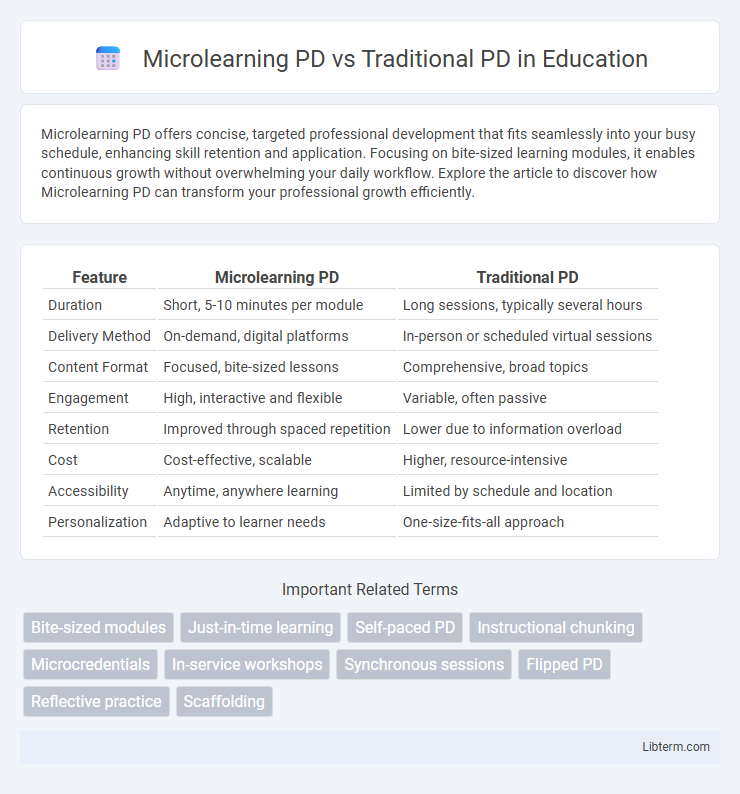Microlearning PD offers concise, targeted professional development that fits seamlessly into your busy schedule, enhancing skill retention and application. Focusing on bite-sized learning modules, it enables continuous growth without overwhelming your daily workflow. Explore the article to discover how Microlearning PD can transform your professional growth efficiently.
Table of Comparison
| Feature | Microlearning PD | Traditional PD |
|---|---|---|
| Duration | Short, 5-10 minutes per module | Long sessions, typically several hours |
| Delivery Method | On-demand, digital platforms | In-person or scheduled virtual sessions |
| Content Format | Focused, bite-sized lessons | Comprehensive, broad topics |
| Engagement | High, interactive and flexible | Variable, often passive |
| Retention | Improved through spaced repetition | Lower due to information overload |
| Cost | Cost-effective, scalable | Higher, resource-intensive |
| Accessibility | Anytime, anywhere learning | Limited by schedule and location |
| Personalization | Adaptive to learner needs | One-size-fits-all approach |
Introduction to Microlearning and Traditional PD
Microlearning professional development (PD) delivers focused, bite-sized training modules designed for quick comprehension and immediate application, often using digital platforms to enhance accessibility and engagement. Traditional PD typically involves longer, scheduled sessions such as workshops or seminars, emphasizing comprehensive coverage of topics but requiring significant time commitments and less flexibility. Microlearning's modular approach caters to modern learners' preference for on-demand education, contrasting with the linear, instructor-led model of traditional professional development.
Key Differences Between Microlearning PD and Traditional PD
Microlearning PD delivers content in short, focused segments that enhance retention and accommodate busy schedules, whereas Traditional PD often involves lengthy, less interactive sessions that can lead to disengagement. Microlearning emphasizes just-in-time learning and practical application through digital platforms, contrasting with Traditional PD's reliance on in-person workshops and lectures. Metrics show microlearning increases knowledge retention by up to 80%, while Traditional PD retention rates typically hover around 20-30%.
Advantages of Microlearning PD for Educators
Microlearning PD offers educators concise, targeted training modules that enable faster skill acquisition and immediate application in classrooms, enhancing teaching effectiveness. This approach increases engagement and retention rates by delivering content in bite-sized, manageable segments compared to lengthy traditional professional development sessions. Flexible access through digital platforms allows educators to customize learning schedules around their busy workloads, promoting continuous improvement without disrupting instructional time.
Challenges of Traditional PD Methods
Traditional professional development (PD) methods often face challenges such as limited engagement, time constraints, and lack of personalized learning paths, which can hinder effective knowledge retention. These conventional approaches rely heavily on long workshops or seminars that may disrupt regular work schedules, resulting in reduced participation and motivation. Furthermore, traditional PD frequently struggles to provide immediate application and feedback, diminishing its overall impact on skill development and job performance.
Flexibility and Accessibility in Microlearning PD
Microlearning PD offers unparalleled flexibility by delivering bite-sized training modules accessible anytime and anywhere, enabling educators to fit professional development into their busy schedules seamlessly. Unlike traditional PD sessions that require fixed times and locations, microlearning leverages digital platforms for on-demand access via mobile devices and computers. This accessibility empowers continuous learning tailored to individual pace and needs, driving higher engagement and retention among educators.
Engagement and Knowledge Retention Comparison
Microlearning PD enhances engagement by delivering content in short, focused bursts tailored to learners' attention spans, resulting in higher participation rates compared to traditional PD sessions that often suffer from fatigue and disengagement. Studies show microlearning boosts knowledge retention by up to 20% through spaced repetition and active recall, while traditional PD formats frequently lead to cognitive overload and lower long-term retention. Incorporating interactive elements and real-world applications within microlearning further solidifies learning outcomes, outperforming the passive delivery methods typical of conventional professional development.
Cost-Effectiveness of Microlearning vs Traditional PD
Microlearning professional development (PD) significantly reduces costs by delivering targeted, bite-sized content that minimizes time away from work and lowers training logistics expenses. Traditional PD often involves extensive in-person sessions, travel, and material costs, making it less cost-effective for organizations seeking scalable solutions. The flexibility and on-demand nature of microlearning also enhance employee retention and application of skills, further maximizing return on investment compared to traditional PD models.
Scalability and Implementation in Schools
Microlearning professional development (PD) offers superior scalability compared to traditional PD by delivering concise, focused modules that can be easily accessed by educators across various school settings. Implementation in schools is streamlined as microlearning can be integrated into existing schedules without requiring extensive time commitments, allowing for continuous skill development and immediate application in classrooms. Traditional PD often involves in-person sessions or lengthy workshops, which can limit scalability and pose scheduling challenges for consistent educator participation.
Measuring Effectiveness: Microlearning PD vs Traditional PD
Measuring effectiveness in Microlearning PD reveals higher learner engagement and retention rates compared to Traditional PD due to its targeted, bite-sized content delivery. Data shows Microlearning PD increases knowledge retention by up to 20% over traditional models, facilitating quicker skill application and on-the-job performance improvements. Traditional PD often relies on longer sessions with less frequent reinforcement, resulting in lower immediate retention and delayed behavioral changes.
Future Trends in Professional Development for Educators
Microlearning PD offers targeted, flexible modules that accommodate educators' busy schedules and promote continuous skill development, contrasting with traditional PD's often lengthy, standardized sessions. Future trends emphasize personalized learning paths powered by AI and data analytics, enabling educators to access timely, relevant content that addresses specific classroom challenges. The integration of microlearning with digital platforms is set to transform professional development by making it more adaptive, efficient, and learner-centric.
Microlearning PD Infographic

 libterm.com
libterm.com